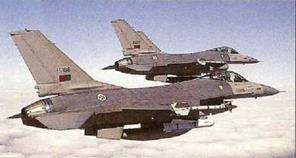Lockheed Martin F-16A/B
|
|
T |
he F-16 Fighting Falcon is the benchmark modern combat aircraft. It was conceived as a lightweight ‘no frills’ fignter for air-to-air combat. The first YF-16 service-tes: prototype was rolled out in December 1973 ard first Hew on 2 February 1974. In 1975 it won a competitive USAF evaluation against the Northrop YF-17 (later developed into the F/A-18 Hornet). The production-standard F-16A (which was preceded by six full scale development aircraft) was very similar to the YF-16, though it had an enlarged wing, greater fuel capacity and a deeper nose to house the APG-66 radar The F-16 was the first ‘fly-by-wire’ fighter, introducing a revolutionary computer-driven flight control system, commanded by a sidestick in the cockpit.
The first F-16A deliveries to the USAF, along with the two-seat F-16B trainer, began in 1979. These 94 aircraft were built to F-16 Block 1 standard, powered by the F100-PW-200 engine. They were followed by 197 F-16 Block 5s, fitted with the full-standard grey di-electric radome. The F-16 Block 10 introduced minor aircraft changes and 312 were delivered to the USAF. Most Block 1 and Block 5 aircraft were brought up to this standard. Block 5 and 10 F-16A/Bs were exported to Belgium, Denmark, Israel, the Netherlands and Norway.
Portugal operates the F-16A/B Block 15 OCU, built to the same standard as the F-16 Block 15ADF and powered by the F100-PW-220E engine.
The F-16A/B Block 15 introduced the larger ‘big tail’ hn and wider tailplanes, The APG-66 ‘adar was improved and new EW and іFF systems were fitted. Earlier F-16s could be updated to Block 15 standard under the MSIP I (Multi Staged Improvement Programme) Export sales were made to Belgium, Denmark, Egypt, Israel, the Netherlands, Norway Pakistan and Venezuela
A specialist USAF interceptor version, armed with the AIM-7 missile, was developed as the F-16 Block 15 ADF (air defense fighter). These aircraft had four distinctive antennas for the APX-109 IFF system in front of the cockpit. The F-16 Block 15 OCU added some features of the F-16C/D, including the F100-PW-220E engine and ALQ-131 ECM pod. OCUs have been delivered to Belgium, Denmark, Indonesia, Netherlands, Norway, Pakistan, Portugal and Thailand,
The European F-16s are now undergoing the F-16 MLU (Mid-Life Update) bringing them up to Block 50 standard, through the add tion of AIM-120 AMRAAM, AN/APG-66fV)2 radar, colour cockpit MFDs, and precision weapons capability.
The final F-16A/B variant was the F-16 Block 20, delivered to Taiwan, which is also virtually identical to the F-16C Block 50.

|












